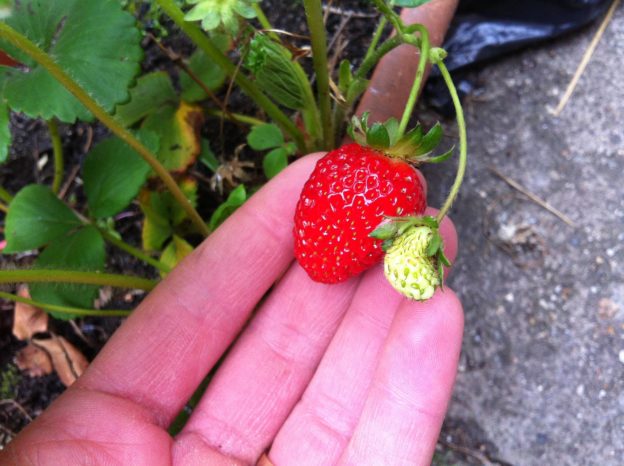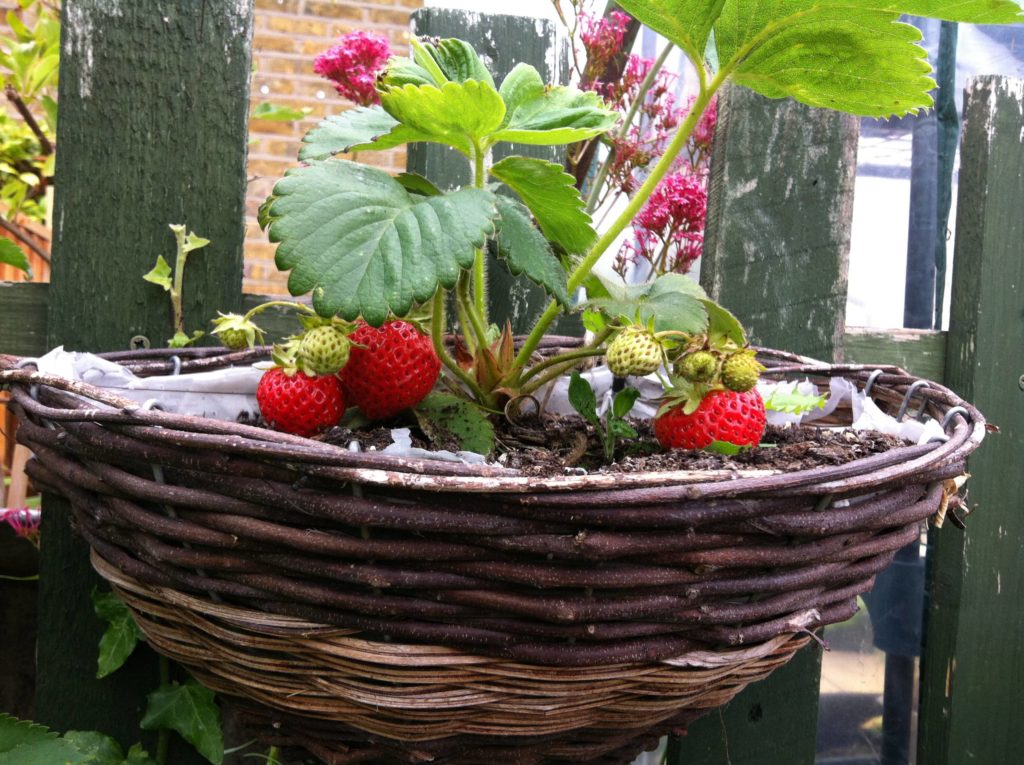Yesterday (20th June), marked the official start of our strawberry season. We harvested our very first ripe strawberry of the year, and it surprisingly wasn’t the one in the basket at the front of the house that was on the verge of ripeness a week ago. Instead it was one in a pot in the back yard. We’re still yet to get round to arranging the back yard and it is currently strewn with plants in pots from the old house. Most of these pots contain strawberry runners that I have kept. It was one of these that was bearing a fruit that I’d been watching for a couple of days as it approached ripeness. Yesterday it was finally there and it was promptly picked and quartered to be shared (and enjoyed) by four of us.
We grow three varities of strawberry, and have done for years. As with most other things I’ve grown historically, I had big ideas, but then neglected them a little. In the case of the strawberries, I saved many runners and planned to be self-sufficient in strawberry plants. I was very organised and planned to keep the plants together by variety. However, four years ago we moved house and the pots all got jumbled, and I had no idea which plant was of which variety. In subsequent years I’ve meant to put a marker next to each plant at the point they fruit (and I can therefore identify them), so that the next year I know what I’m dealing with. I still haven’t done it, but I’ve decided this year is the year! To compound the problem further, when I’ve saved runners from these unidentified plants, I’ve not been able to mark these either, resulting in a new generation of mystery plants.
The three varieties we grow are the classic mid-season variety Cambridge Favourite, a more modern everbearing variety named Albion, and finally wild (or alpine) strawberries. The latter are actually foraged plants that birds have kindly planted for us in amongst other plants we’ve grown. When I’m weeding I can’t bear to throw them away, so they get put in pots. The kids like them, and we tend to get a large harvest of these very small fruits throughout the whole of the summer. The other two varities I purchased years ago, and I have been saving my own runners ever since.
The wild strawberry plants have leaves that are visibly different from the cultivated varieties, so there is no confusion as to which plants are the wild ones. The confusion for me is between the Albions and the Cambridge Favourites. When they are bearing fruit I can tell them apart, as the Albion strawberries are rather conical in shape. The fruit that ripened yesterday is from an Albion plant, and the other two plants in that pot are also bearing conical fruits, so I can mark that pot as containing entirely Albion plants.
The Albion variety does boast some impressive features. It is a great tasting everbearer that is resistant to verticillium wilt and phytophthora crown rot. The Cambridge Favourite was the first variety I ever grew, and I have done so continuously since. It also has great disease resistance and an excellent flavour. It is also famous for being a reliable cropper that isn’t particularly fussy about soil type or growing conditions.
In case you were wondering, the strawberry that was very nearly ripe in the basket at the front of the house a week ago, is still not entirely ripe. I haven’t got round to putting any straw under the berries to prevent contact with the soil, but I have been resting them on the leaves of the plant for now. Lifting the berry to examine it yesterday, I discovered that it is still not red all over. There are another two fruits on the same plant that are also just on the verge of ripeness. Incidentally, this plant was an unidentified runner that I saved last year. Now that it has borne fruit I can see that it is a Cambridge Favourite. I must remember to put a marker in!



